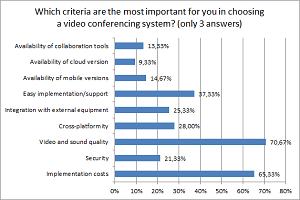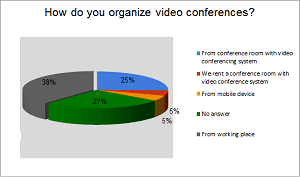Price and Quality: Basic Selection Criteria for CIS Video Conferencing Systems Customers
TrueConf has compiled the results of the annual industry survey conducted during the company’s yearly seminar. Video+Conference 2013 was attended by 75 specialists and heads of IT from various business enterprises and organizations in the CIS. Over 65 percent of the survey respondents consider the cost of implementing video conferencing systems, as well as video and audio quality, to be the key considerations when selecting a video conferencing system.
Key Consumer Priorities and Preferences
Video and audio quality were the most important criteria for 70 percent of the respondents. Twenty percent to 28 percent of respondents were also interested in security and cross-platform integration with external equipment. Interestingly, the common needs of Western customers, such as the availability of cloud and mobile versions of video conferencing products and services, are not emphasized as much in the CIS.
The majority of CIS respondents indicated they prefer dedicated video conferencing solutions to cloud-based ones. However, there has been a significant decline of interest in dedicated solutions over the last year: only 49 percent of the respondents preferred to own a video conferencing system, compared with 70 percent last year. Almost 27 percent of those present at the event preferred web conferencing and about 11 percent preferred cloud video conferencing.
According to our data, the CIS video conferencing market still has great growth potential, as more than 20 percent of the respondents do not use video conferencing as a means of communication, but show interest in it. Over 80 percent of the respondents plan to expand their video conferencing systems, while 27 percent of them are willing to replace the old system with a new one that will better meet their needs.
At present, over 57 percent of the respondents organize video calls directly from their workplace desktops. This imposes certain requirements for their video conferencing systems: they should be simple to use, should not occupy much space and have moderate system requirements. Until recently, about 45 percent of the respondents use conference rooms equipped with video conferencing systems, but there is a visible downward trend.
The undisputed leaders among video equipment are web-cams or built-in cameras, which scored 76 percent of the vote. Next came PTZ cameras: they are used by 35 percent of the respondents. IP cameras scored 20 percent of votes, and document cameras got only 10 percent.
The statistics on the audio equipment turned out to be as expected: the most popular are built-in speakers/microphone (selected by 65 percent of the respondents), approximately 50 percent of the respondents use headsets and audio system with a mixer, a third of those present at the event chose speakerphones and only 1 percent picked microphones as their primary equipment.
The participants were also interested in video conferencing news. More than 76 percent of the respondents said they enjoyed the reports at the seminar, and 75 percent of the participants expressed a desire to receive more video conferencing news. Last year, only 60 percent of those present at Video+Conference were interested in receiving news about the video conferencing market from TrueConf and Wainhouse Research.
About TrueConf www.trueconf.com
Founded in 2003, TrueConf is one of East Europe’s leading video conferencing vendors. The company is focused on collaboration solutions and offers an SVC-based MCU-less unified communication software platform. TrueConf has developed a full software suite suitable for corporate IP networks and all popular PC and mobile platforms, offering the convenience of both cloud-based (TrueConf Online) and server-based (TrueConf Server) video conferencing products. TrueConf Server offers a Full HD video experience and the ability to support multi-point video conferences with up to 250 participants (using UDP Multicast).
TrueConf has facilitated over 1300 successful video conferencing solutions for governments, educational institutions, financial establishments, small businesses and corporations involved in all types of activities. The company developed the world’s first 3D video conferencing application and has made significant advances in mobile conferencing and gesture-control video conferencing systems.
Video conferencing software for business, education, telemedicine and government.





Follow us on social networks